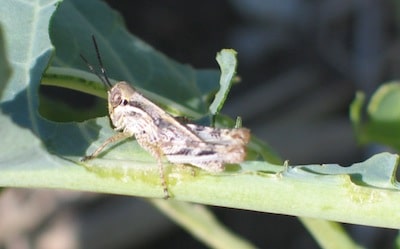Grasshoppers may be above thresholds in some fields. The nominal threshold for grasshoppers in canola is 8-12 per square metre, although the higher end of that range may be more appropriate in a typical canola crop. Grasshoppers are often at higher numbers at field margins, making a targeted spray possible. Scout to see where that line is. In some cases, they will migrate across fields. How to count them.
Lygus will feed on canola buds, but canola plants will usually compensate for this feeding and may actually yield more as a result. (References to this concept are provided in this article.) Watch closely while scouting, and consider marking off an area and going back regularly to make sure it goes into flower. Only if lygus prevent canola from going into flower would spraying at the bud stage be warranted. (Remember, if the cause is due to the mystery syndrome described in the other article this week, then the crop will recover anyway. Leave a check strip to verify if an insecticide application was useful.) Otherwise the time to spray, if sweep netting suggested numbers at economic thresholds, is at the pod stages. More on lygus thresholds.
Cabbage seedpod weevil. The goal is to stop adults from laying eggs in newly formed pods. CSPW don’t do their major damage until pods are 3/4″ to 1” long — so aim to spray just prior to that stage, at about 15-20% bloom. Use a sweep net to sample at least 5 spots along the field edge. Click here for tips on how to use a sweep net. If more than 2 per sweep, sample another 5 spots about 150 feet into the field. More scouting tips here.
Root maggots have been found at high numbers in some fields. Look for plants wilting at early flowering. General wilting is likely environmental, but patches or individual plants could have some other cause. Dig them up carefully and look at their roots for clubroot galls, root diseases and cabbage root maggots. Maggots boring into taproots can be an entry point for disease, so you may see both. If the plant taproot breaks off slightly below the soil surface, then root maggots are likely suspects. Look for maggots or tunneling. If the plant is girdled at or slightly above the soil surface, and taproots are not tunneled by root maggots, then a disease is more likely. No insecticides are registered or provide an economic benefit on root maggots. Crop rotation can provide effective management when numbers are high enough to cause yield loss.
Multiple insects and combined thresholds. Many canola fields have a combination of insects feeding on the crop, including lygus bugs and cabbage seedpod weevils. Economic spray thresholds are calculated based on individual species. We don’t have scientific evidence to combine thresholds, but where an “additive” effect of multiple species can make sense is when more than one species are feeding on key yield-producing areas — flowers, buds or pods — at the same time. For example, lygus and cabbage seedpod weevil will both feed on pods. If they are in the same field and if they are both at 50% or more of their economic spray thresholds, spraying may provide an economic benefit.
